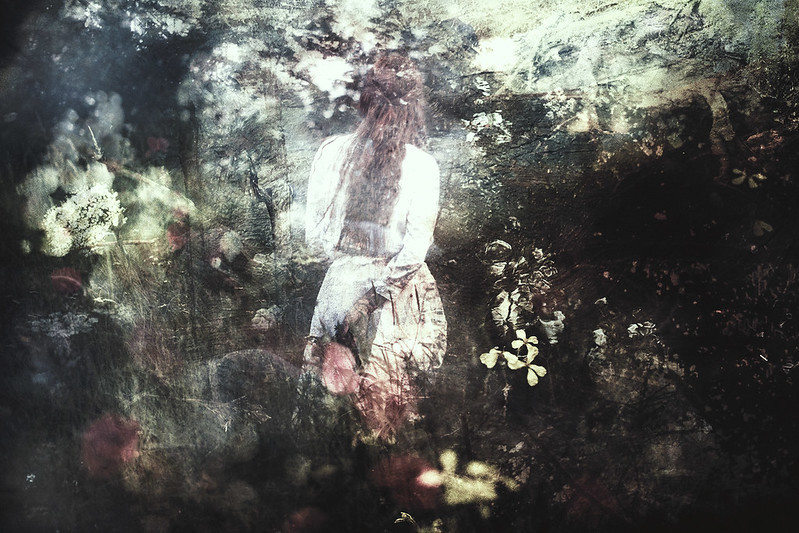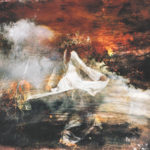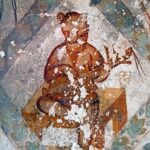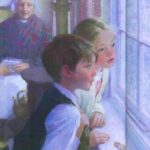Dear reader,
This is part of my series on fairytales “The Story Threads” where I discuss the esoteric symbology and layers of wisdom found in famous tales, lore and myth, and how it all relates to our current times and the evolution of our consciousness. Previous posts in these series include What Cinderella Knows, What Sleeping Beauty Knows, What Rapunzel Knows, Wild Marriage, The Gift of the Magi, The Dandelion Girl, What Snow White Knows, Beauty and Her Beast, Weaving Life, and True Lover’s Kiss.
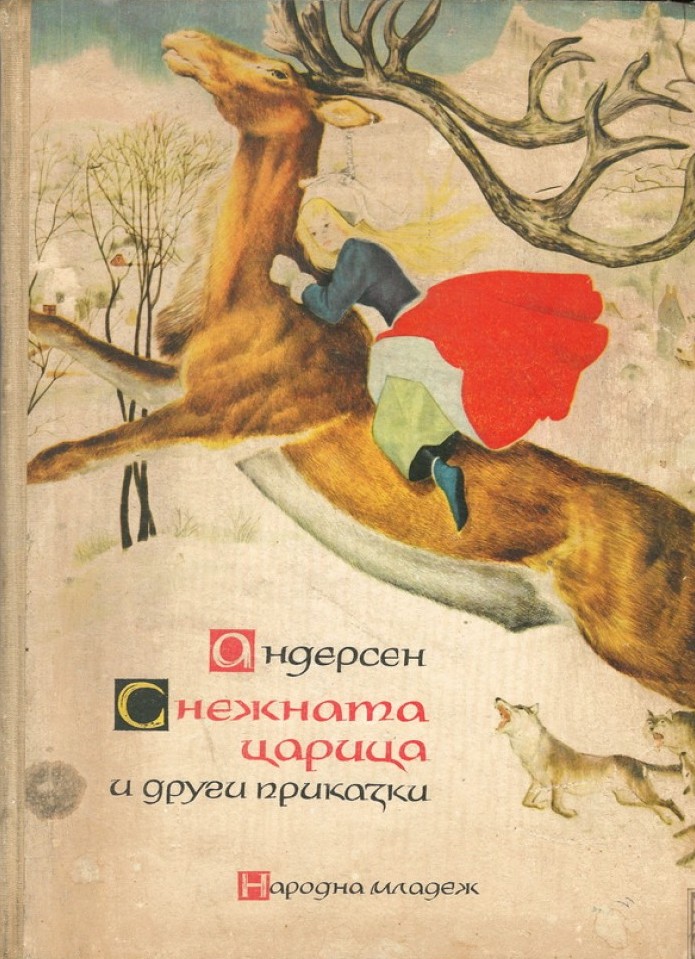
My childhood book “The Snow Queen” illustrated by Benvenuti
Storytelling and symbology are powerful. Many stories, fairy tales and myths are actually following a very basic archetype using esoteric symbology; they are old myths that are retold and recreated all the time throughout history and throughout cultures. Specific stories actually work in our subconscious as a vehicle of remembering, of initiation and of awakening.
Often times, they awaken our psychic ability and retrace a shared path of humanity; we retrace information stored in our consciousness from past lives, which awakens us and connects us in a deeper way. These stories access and engage with our subconscious causing us to connect to parts of us that are deeply ingrained in our soul.
This is also why sometimes we read or watch something, and it just makes sense to us even if we don’t understand why; it is part of our consciousness perhaps from past lives – it runs as a stream in our being, woven in our soul. These stories and myths access our super-consciousness because of this resonance and we begin to remember and to awaken who we truly are.
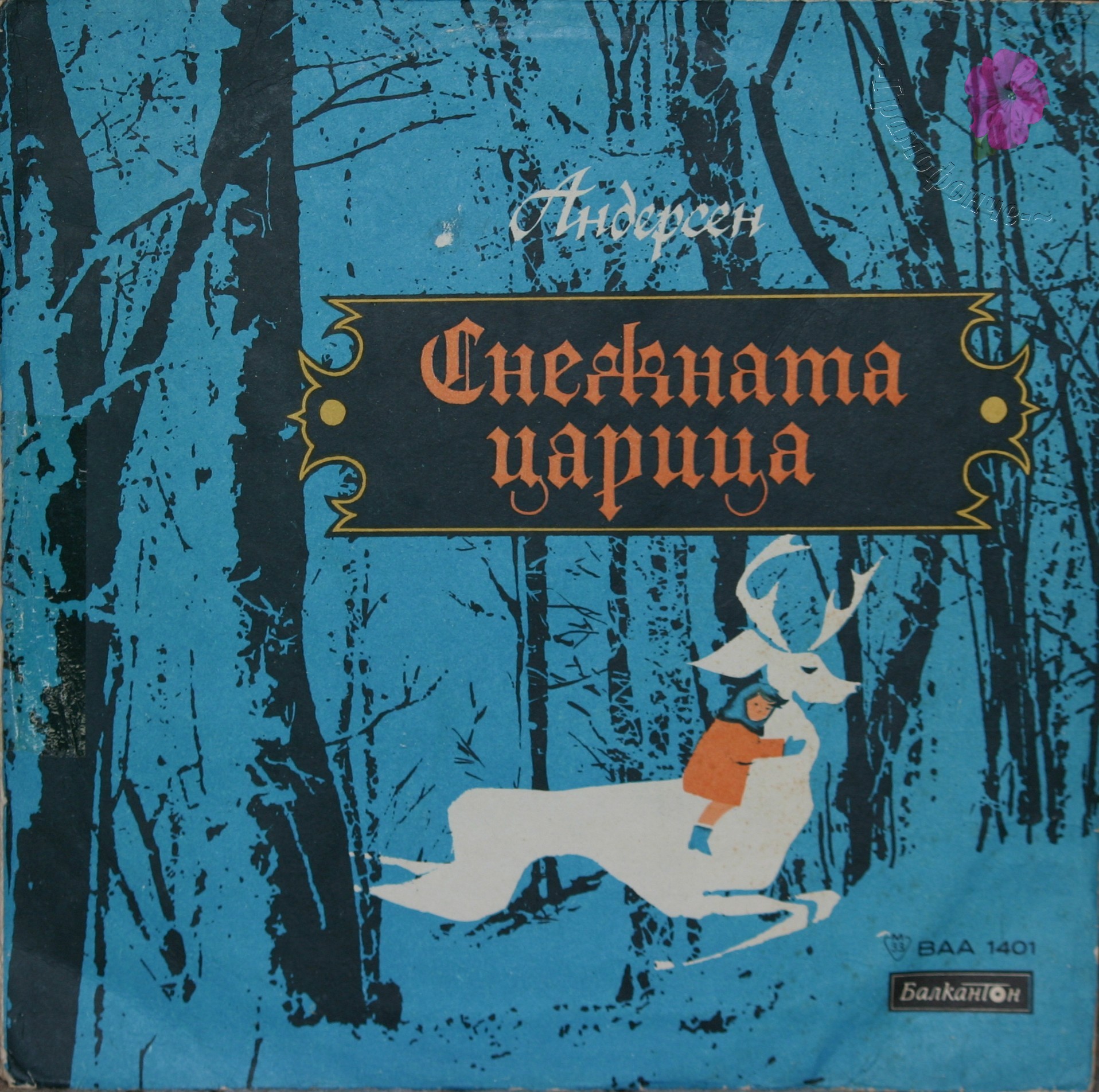
The vinyl record of “The Snow Queen” that I listened to as a child
This evening we’ll discuss my most beloved fairytale of all, The Snow Queen by Hans Christian Andersen.
Let’s begin.
Many mystical moons ago, when I was a child wild, romantic and imaginative, I’d sit on a yellow couch every afternoon at three o’clock; my grandmother would pour me some tea and then play the vinyl record turning fairytales while she did her work in the house. It’s funny how some moments become snapshots – like polaroid photos. They stay forever in our minds.
I must have listened to many tales and yet the one that I always remembered, the one that stayed with me forever since, is The Snow Queen by Hans Christian Andersen. Not just a polaroid photo in my mind, this tale enamoured my very being and from the first time I heard it, it somehow spoke to my soul in a way perhaps unfamiliar yet deeply known.
The Snow Queen is a story about a boy, Kay and a girl, Gerda. They have a rose garden on the rooftop, like the one I always dreamt of having someday.
It’s a story about love. About trust and believe. About the core essence of who we are. About the deep knowing in our soul pulling us as desire towards itself.
It is a story about the power of the heart and the power of love.
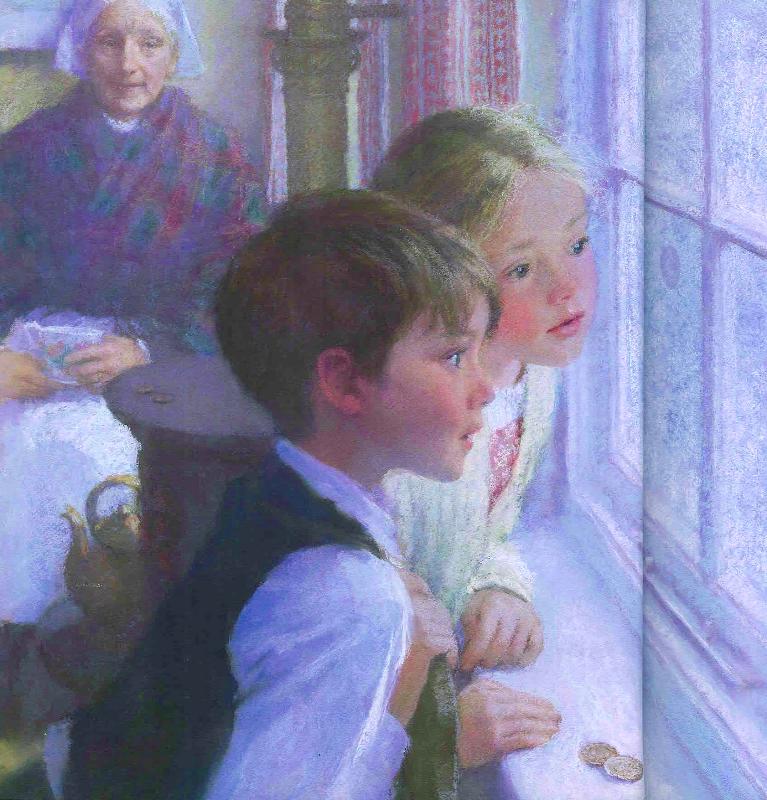
“The Snow Queen” illustrated by Christian Birmingham
What attracted me to that tale as a child, aside from the roses and dreaming that I’ll someday have a rose garden, was the theme of love running through it; the knowing that Kay is out there even though she never knew for certain, and how despite all obstacles and doubts, she kept going following the beat of her heart. As I already said, I was, and still am, quite the romantic soul.
I also loved how connected Gerda was to animals and how humble and real she was; she had doubts and discouragement along the way, she trusted the wrong people and even made some wrong turns, she was tender yet stubborn, she was innocent yet wise, she lost herself and then found herself, she made mistakes, and yet her heart remained pure.
No matter what happened she stayed true to herself and just when she’d give up all hope and would confess it’s all nonsense to continue forward, there would always be something, whether an omen or a person, who would give her a little hope and she’d go forward towards believing.
Gerda looks for her love Kay because once we’ve experienced love, it is unforgettable and impossible to erase; nothing else will ever fill our heart once love has kissed us. What happens in the tale is that along the way, Gerda sometimes gets used by others – she is held hostage by a girl who adores her and wants her to be her friend, she is held hostage by a witch who, again, adores her and wants to keep her in her home forever, and she even often comes across people who just don’t know how to express love and affection towards her in return.
In times like these, when we feel unsupported, lost, alone, unloved, unappreciated, we often look around and say, “Where did the love go? Why aren’t they being loving and compassionate and affectionate towards me the way I am with them? Where is the compassion now?” It’s as if the Sun suddenly asking, “Where is the Sun?” It’s you darling, you are the Sun. Sometimes this is what happens to us – we are asking where did the compassion and love in this world go – well, we are it. Through our expression of love, through our willingness to forgive, to flow, to believe, to trust, to show affection, to see the beauty in the tiny moments, to feed the animals – all those people around us get to experience love; they get an opportunity to respond to love, to show us affection and be loving towards us, to show us compassion, and to even change for the better; some will, and others wouldn’t, and maybe years down the line they’ll remember our gestures – but the point is, we stay true to our heart.
Gerda is the love – she is the love, the hope, the trust, the faith, the compassion, the forgiveness, the purity of heart that all those around her experienced along the way; she was the tool through which all those around her experienced love and beauty in their worlds. And while she may have thought that love was gone, taken away from her on a winter’s day, it was with her all along but she just couldn’t see it – because she was it.
Gerda is the expression of divine love itself; she is the extension, the tool through which God and Christ show others what true love and compassion really are; and it is through her that others experience love.
As I grew older and started studying tales and mysticism more deeply, I found that this fairytale carries within it deep esoteric symbolism and layers of wisdom.
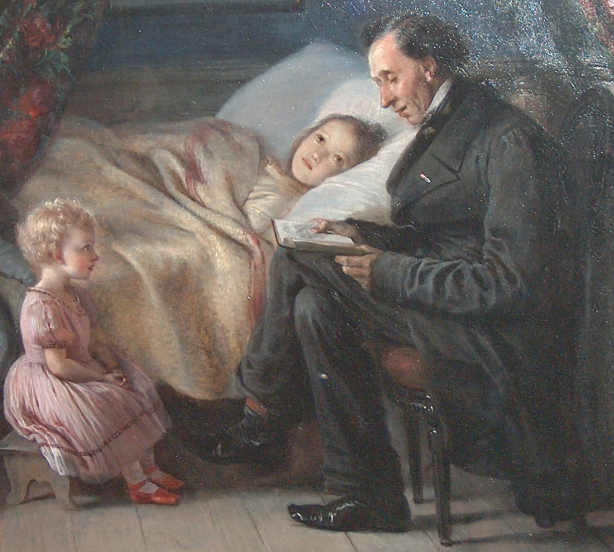
Hans Christian Andersen illustrated by Elisabeth Jerichau-Baumann
Andersen himself was a spiritual man and it is no wonder that these esoteric aspects would be present in the tale’s symbology. Despite the Christian imagery recurrent in his tales, which was typical of nineteenth century fiction, his writings are actually incredibly earthy, anarchic, spiritual rather than dogmatic, and introspective rather than morally instructive. And while there are Bible quotes in some of his stories, including The Snow Queen, it is more spiritual than religious.
Andersen was a writer during the times of Romanticism and this influence can be seen in the romantic tones of his storytelling. He also grew up reading and loving Thousand and One Nights, which were some of my favourite stories as a child and I still have these books on my shelf.
In Andersen’s tales we actually see the revival of the imaginative spirit and the power of the independent voices, as he was not a writer who came from wealth nor education. He actually grew up uneducated and poor, and was financially dependent on friends until the age of 33 when the King of Denmark awarded him an annual writing stipend for life.
In a way, he also took on the shift of perspectives and the cultural decentralization, particularly when he expressed in his tales the perceptions of children, animals and those of the lower classes. His original tales were not as sweet and childlike as people may think but due to the lack of sophistication in their English translations, they were made to be sweeter, more naive and more childlike, which categorized him as a children’s writer. He was quite disatisfied with that and kept saying that his tales were meant for older people as much as young, for their wisdoms were only possible to be understood when a person is more mature. But unfortunately he didn’t speak any English and this “childlike, naive” reputation, referring to both him and his tales, stayed with him in the rest of Europe.
The Snow Queen is sometimes seen as a reflection on humanity and our human nature, portraying what happens to us as human beings when we lose touch with our heart, tenderness, trust and most importantly, when we lose connection to our true inner self and to one another.
Who has not, like Gerda, been exiled from their familiar comforts of the world they once knew; of the time when perhaps a beloved, person or a dream, was taken away from them? What child, and adult, has not been faced with challenges and a version of reality collapse, when mystical hands reached out to us to limit our experience? Who has been forced to feel a deep yearning that no one else, aside from just one person, could soothe?
Like Kay, who hasn’t experienced despair and a frozen heart, feeling lost from what once warmed his tender heart? Who has not felt estranged in a faraway distant land? Who has not sometimes retreated into a fortress, shining and bright as ice snow, yet lonely and colourless because there was something still missing? Who has not surrounded themselves with logical, material tasks, or work, just to soothe their heart, yet it never truly worked, because when left alone, at night, the soul was still yearning? Who has not romanced a cold Queen, or King? Who has not mistaken intensity and newness for meaningfulness? Who has not denied sometimes the blessing of creativity and the freedom of the soul? And who has not negated their own self, believing themselves unworthy and unloved, and withheld compassion from their self, despite the loving kindness of their friend, family or beloved?
Analyzing the tale, one might think Andersen himself was quite knowledgeable in alchemy, as the narrative perfectly describes the alchemical process of integration, as well as the archetypes of anima-animus described by psychologist Carl Jung in his theory of the collective unconscious. Carl Jung was interested in the occult and actually practiced astrology in his analytical psychology work. He described the animus as the unconscious masculine side of a woman, and the animaas the unconscious feminine side of a man, each transcending the personal psyche and ego.
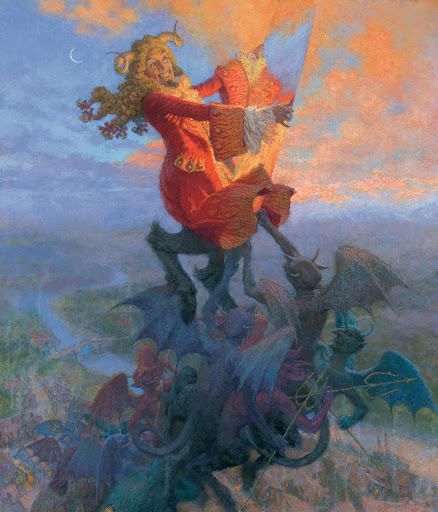
“The Snow Queen” illustrated by Christian Birmingham
Fragments of the Self.
In the first chapter of the tale, we see the devil crafting a mirror, which causes everything good and beautiful in life to be reflected as worthless and ugly. He feels great joy whisking the mirror all across the world, and even greater joy at the idea of lifting it high enough to God and the angels. However, as he lifts it higher, the intensity of the high love vibration in the divine realms causes the mirror to shatter, scattering all its pieces across earth.
One such piece ultimately enters Kay’s eye. At first he starts seeing all things ugly, and he becomes angry, bitter and mean towards Gerda, who is his one true friend. The piece then goes into his heart, causing it to freeze, and so he becomes completely detached from his own feelings, kindness and compassion.
Kay becomes coldly logical, and dismisses play and affection from Gerda; he becomes obsessed with patterns, smashes the roses and storms out of the house.
He goes in the plaza where eventually he ties his sled to the back of the Snow Queen’s sleigh – because he now resonates with that coldness and detachment. This is following one of the universal laws of esotericism, which is the law of resonance. And as Jane Goodall says, “The end of our world will be apathy.”
The mirror symbolism portrays the gateway through which “the devil” operates; he becomes a gateway into our unconscious not by he himself, but as the perspectives which he provides, and we then choose whether to take on as our own. Evil will always exist, but perhaps the only way to defeat it isn’t to deny it thereby resisting it which will only cause it to persist, but to not pay attention to it giving it more energy – and to stay true to our higher values and stay connected to our heart.
When we think that everything externally will be perfect and beautiful and Godly, we are only paving the road to disappointment, which will then turn us bitter. There is higher purpose in allowance, acceptance and deeper understanding; that we must focus inwardly and stay heart-centered. It is the same with emotions – if we are not accepting of our feelings and various aspects, we will be suppressing ourselves, which leads to further fragmentation, separation and aggression. In criminal psychology and behavioural science, all serial killers have deeply suppressed and repressed emotions from childhood, along with undealt, unprocessed trauma. We all get angry, we all feel weak, we all feel jealous, we all feel doubtful, we all feel disappointed, we all feel defeated, we all feel unneeded and unloved sometimes; that’s okay, just validate and acknowledge your feelings and they will then move away like water’s waves.
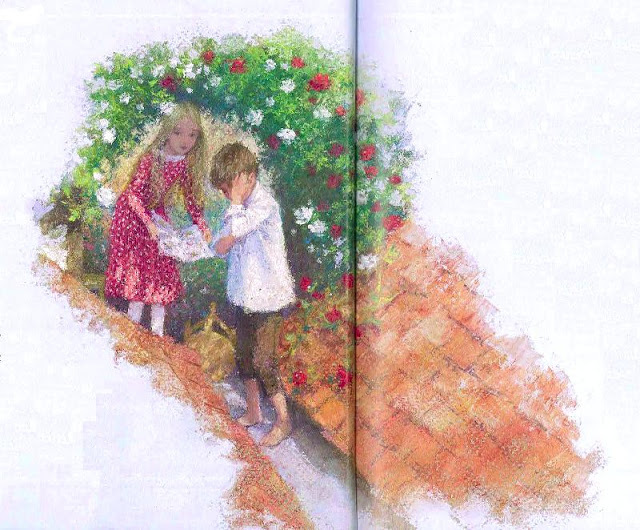
“The Snow Queen” illustrated by Christian Birmingham
The symbol of the rose is very powerful, yet it almost goes unnoticed by many scholars or analysts of the tale, perhaps because roses were commonly used in literature. In esotericism, the rose’s petals actually form the womb of Self and are connected to divinity, fertility, birth, devotion, divine love and Christ’s passion for humanity. Roses are the birth flowers of June and are connected to the elements of water and the planet of Venus; roses have always represented the deepest and truest love of all. Roses also feature in many tales and myths, and my favourite is connected to the love story of Eros (Cupid) and Psyche. Following the romantic wedding of the two lovers, the Graces (Zeus’ daughters), being so happy and all, made the entire earth glow with roses.
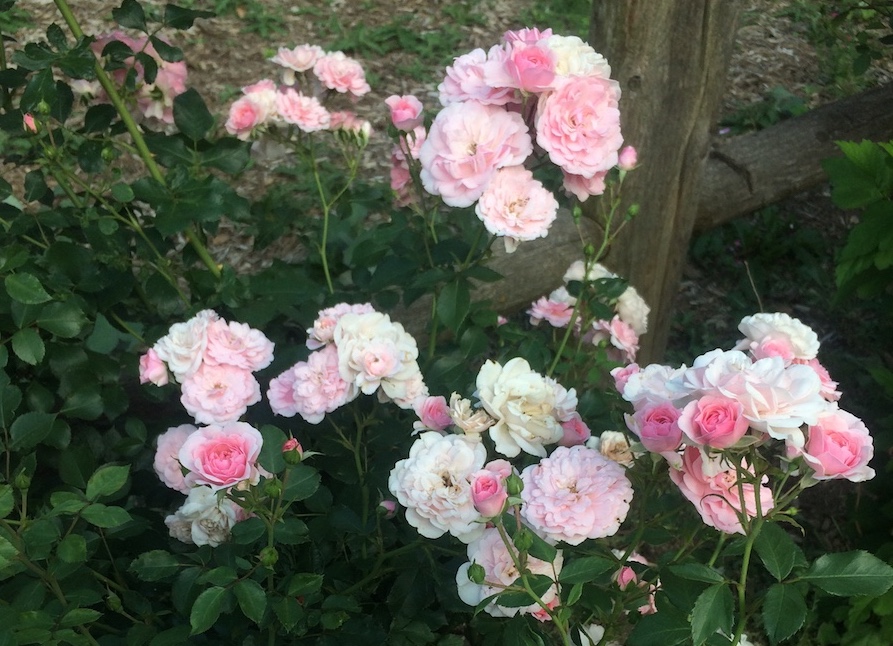
The wild roses from my rose garden.
This becomes even more meaningful when we understand that Psyche is the embodiment of the soul, also known as the breath of life, and she marries Eros, or Cupid, who is the God of love and desire. When we breathe life into the desires of our soul, when we marry our beloved, when soul merges with love, roses grow and adorn the earth.
The rose is also connected to Christ and Mother Mary – the unconditional love, kindness, compassion, appreciation, gratitude, charity, empathy, surrender, grace, forgiveness, trust, loyalty and faith. In our story, it is Gerda. She is the embodiment of all of these qualities, because she retains her true sense of self despite the challenges she faces; just like a rose is a rose is a rose. In the tale it is referenced that she is the Christ child:
where roses bloom so sweetly in the vale, there you’ll find the Christ child, without fail.
In the tale, the rose garden sits on the rooftop shared between Kay and Gerda’s homes – joining the conscious and unconscious, and theirs souls and hearts as one.
Through the story and its characters, we see when we lose our childlike innocent qualities and become a part of the materialistic world, full of skepticism, coldness, detachment and overly left-brain thinking, away from the warm nurturing, imagination, affection, feeling and heart connection – we begin to freeze and harden hearts. As we discussed, when we are disconnected from our heart, this is when deception crawls in and we arrive at a state of crisis of consciousness. And when we forget who we are at our core of self and heart, we begin to look outward, elsewhere, for satisfaction and fulfillment.
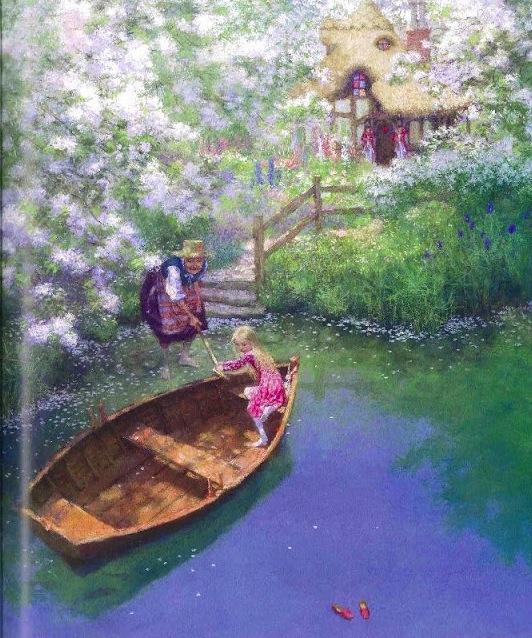
“The Snow Queen” illustrated by Christian Birmingham
Meanwhile Gerda decides to look for Kay; she puts on her red new shoes and walks down the river, to ask the river whether Kay is dead or alive.
Her red shoes are her only possession and for a girl coming from a humble poor background, she still knows the true value and meaning of things. She doesn’t hesitate at all to offer her shoes, pleading the river to return Kay back to her. However, the river pushes them back to the shore, for she knows she can’t bring back little Kay. Gerda decides to plead even more and hops into a boat to throw the shoes even further in.
And so she, just like our unconscious intuitive side, gets whisked downstream in the great mysteries of the unknown, eventually barefoot, where only our heart will lead us. It is a surrender. It is a deep trust. The story then goes through many other aspects of soul recognition and the process of our life’s paths, as we move through seasons, cycles, magicians, enchanted forests, and thieves.

“The Snow Queen” illustrated by Christian Birmingham
When we lose ourselves, deep in the forest, we need to remember that the remedy is always tenderness. In the old days the “evil eye” was known as a condition that caused dryness, and we too dry up when faced with challenges. And then we harden up and armour up. Protection is of course needed and we must always protect that innocence and tenderness; these precious gifts are not meant to be shared with anyone not respectful, appreciative or trustworthy. Yet we must also remember that we too need water; we need nourishing, nurturing and compassion especially during our hard times, so that we stay soft-hearted and take one step, after another. Just like Gerda, along the way, things and people will come to remind us of our love and will care for us, support us and help us, but we must be open enough to recognize it and allow it.
Our greatest adversary in life is forgetfulness: forgetting the purity of our heart, our inner truth and ability to love. No matter what has happened in our life, we all have, at least once, been touched by love; by tenderness, compassion, trust, grace and generosity. It is love, and only love, that is the greatest magic of all, the greatest reason for all and the greatest healer of all. To reclaim our true power, we need to remember.
The story of Kay and Gerda is a story of love. We can see them as soulmates, united through their roses, and belonging to one another. No matter where life leads them, it is inevitable that they will be together, because they belong together, they share the home of their heart, they reside in the home of each other’s hearts.
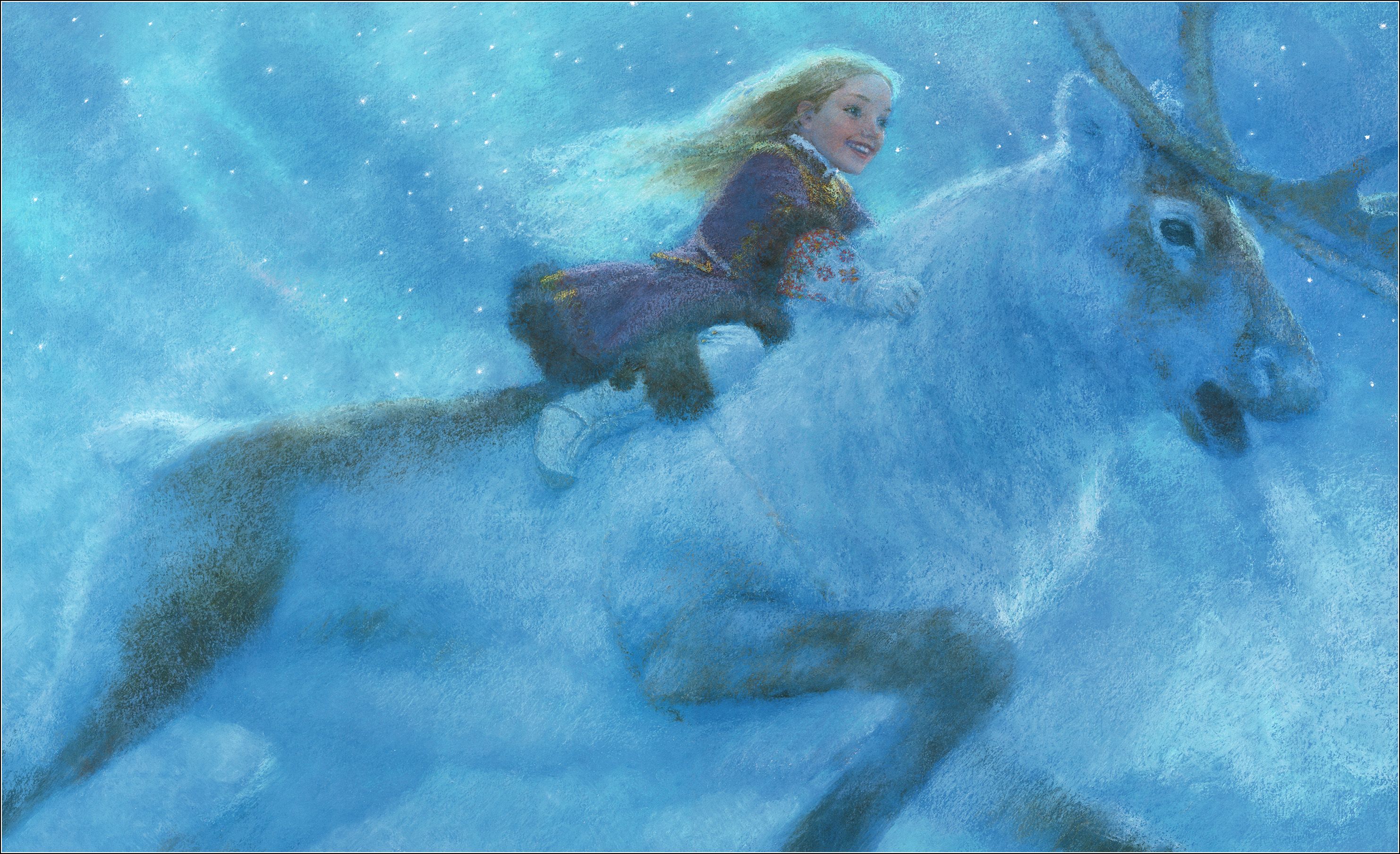
“The Snow Queen” illustrated by Christian Birmingham
The Power of Love.
And the magic woman said,
“Yes, I can tie all the winds and storms with a single thread. But I cannot give her any greater power that what she has already. Don’t you see how strong that is? How men and flowers and animals serve her, and how well she got through the world, barefoot as she is? She cannot receive any power greater than she now has, which is held in her own purity and innocence of heart. It is only this love that can defeat snow kingdoms and melt the ice from Kay’s heart. And even with all my magic, I bow to such power.”
There is no greater power than our heart; the innocence and purity of love. Our heart is the initiatory pathway to higher consciousness. It is not just an organ; it intuitively scans the collective and then translates this information into desires, ideas and passions. What this means is that by the time we get that desire, idea or passion, there is already a need for it in our world. As Rumi said, what you seek is seeking you.
Just like Gerda, we won’t always know where we are going nor why, but we can consciously choose to put on our bright new red shoes and try to listen to the river. There is too much unknown in this world, and in life, but we decide to walk anyway and we do our best to follow the truth of our heart. Our feet will get tired and we might feel lost and discouraged along the way. There are too many questions our mind will ask and we will rarely have the answers. But that’s okay. We were never meant to know it all anyway. One step, and then another, and we will figure it out when we need to. There is an invisible kingdom waiting to guide us.
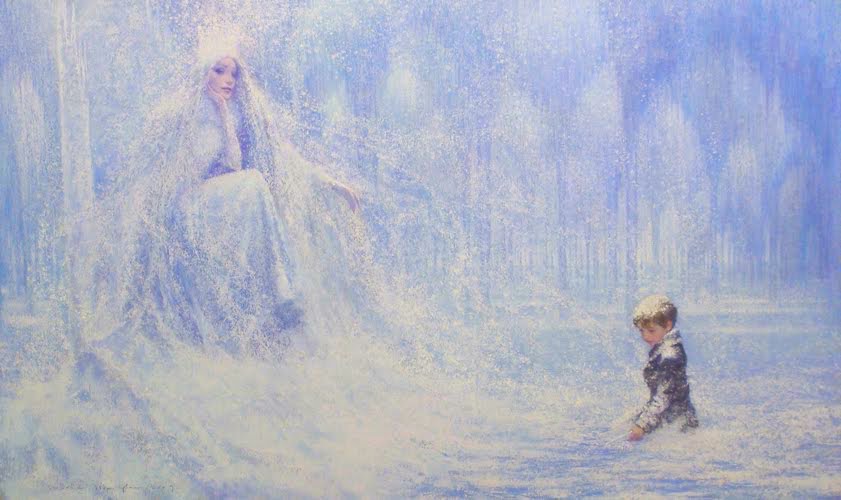
“The Snow Queen” illustrated by Christian Birmingham
As Gerda finally enters the Queen’s castle, we see Kay blue, almost black, of coldness and seriously focused on shifting flat pieces of ice in an attempt to make something out of them. “Kay was cleverly arranging his pieces in the game of ice-cold reason. To him, the patterns were highly remarkable and of the utmost importance, for the chip of glass in his eye made him see them that way. He arranged his pieces to spell out many words; but he could never find the way to make the one word he was so eager to form. The word was “Eternity.” The Snow Queen had said to him, “If you can puzzle this out, you shall be your own master, and I’ll give you the whole world and a new pair of skates.” But he could not puzzle it out.”
Kay’s portrayed obsession with the puzzle in the tale is in ways reflecting the struggle of mankind; to comprehend and experience eternity, to possess it, to liberate himself from it by controlling it and understanding it. We see this reflected in our modern day by transhumanism. We create AI to become something super-human, of higher intelligence, and yet we can’t mimic nor achieve nor even reach the power of the human heart. We can’t reach higher states of consciousness and evolve our soul without the connection to our heart – it is impossible to do it artificially. Nothing can replace creativity, intuition and feelings, all of which are portals to the higher realms. And when our hearts are jaded and when our eyes can’t see the things that truly matter, we can’t even remember ourselves and these ancient truths – we can’t spell eternity. We need our humanness, we need love. We need Gerda.
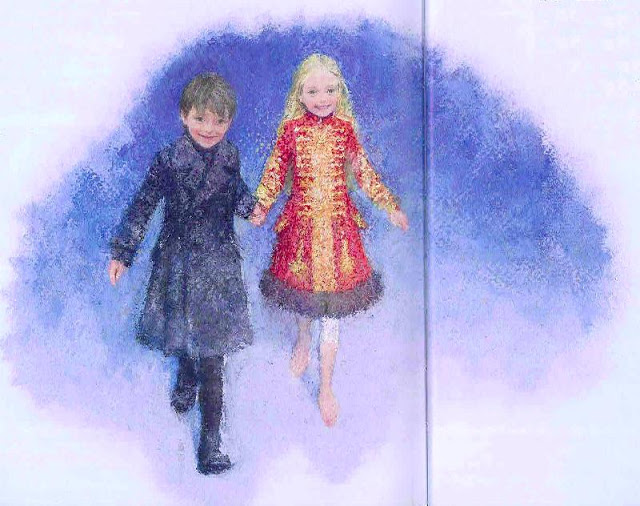
“The Snow Queen” illustrated by Christian Birmingham
And the warmth of Gerda’s tears fell on Kay’s chest melting away the ice from his heart. “Gerda! Where have I been all this time? Oh how I’ve forgotten!”
Gerda’s love is pure like running water. And it is her tears that melt away the ice from Kay’s heart. He then bursts into tears himself and they embrace. Their happiness is so infectious that the glass starts dancing around them, and when it tires, it falls into the shape of the word eternity. Love, for it is true and what is true is eternal, is what forms upon their union. We shouldn’t worry about spelling it ourselves, it will spell itself when our connection to the unconscious melts away the ice from our hearts and allows us to see the world for what it really is.
The roses on the roof looked in at the open window, and their two little stools were still out there. Grandmother sat beside them in the heavenly sunshine and read to them from the Bible: “Except ye become as little children, ye shall not enter into the Kingdom of Heaven.” Kay and Gerda looked into each other’s eyes; there, they sat together, holding hands, the same children still at heart. And it was summer – warm, delightful summer.
With these lines, the tale of The Snow Queen ends. The beauty of this passage from the Bible is in its dual meaning. Yes, we must nourish and cultivate the loving sense of a child’s heart; the innocence and purity of our heart, and curiosity and wonderment of our child-like eyes. We mustn’t become rigid, pessimistic and materialist like Kay, but rather to allow the sweetness and innocence of Gerda to invite the extraordinary into our ordinary moments of life; for magic and miracles are found in our beliefs and perceptions.
And yet there is another meaning to that phrase – we must become as a little child does. Gerda also grows up during the tale; she becomes the adult Gerda, she becomes her highest potential, through the undertaking of the process in the same way that Kay does. We shouldn’t just settle for beingas a child in our heart, we must live as a child, become as child, learn as a child, in an effortless, curious way embracing the beginner’s mind of openness and allowance, until one day we become our true selves. And we remember our deep joys and passions, and we remember to be grateful and appreciate the little things, and we connect to our playful and creative natures, which are unique to us. The greatest gift we can give this world is to be our authentic selves because we all carry something meaningful, creative, unique that waits to be expressed in the world.
In Zen Buddhism there is also the practice of The Beginner’s Mind, which inspires and cultivates the importance of approaching life with curiosity as if all you experience, hear and see is for the first time. With such openness, new possibilities will continuously unfold and we will expand even further within ourselves.
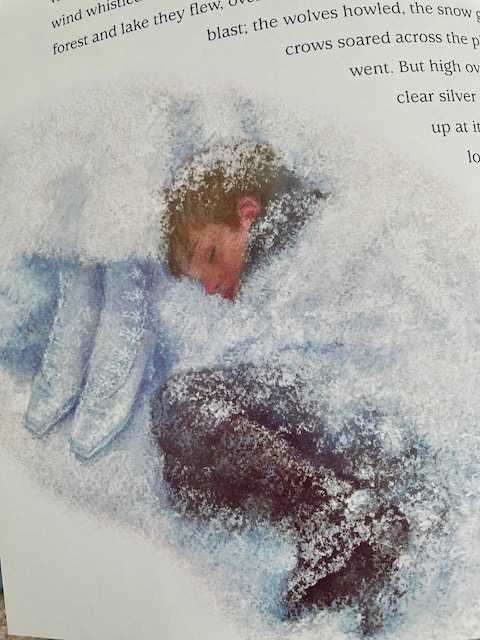
“The Snow Queen” illustrated by Christian Birmingham
We’ve forgotten how to listen to one another and to connect more deeply and authentically. True intimacy requires vulnerability and authenticity, which can’t happen without connection to self first. Our self has become fractured, fragmented and our bodies carry heavier weight in our emotional field of unresolved wounds and fears. When we fail to integrate all aspects of our consciousness, we will fail to recognize the divinity in our self and will also fail to recognize the divinity in another. This leads people to being harmful and hurtful towards others. When there is disconnection from self, we can’t truly connect to higher spirit, and to our deeper core, yet we still need life force energy, which in this case – we’ll get from the external. This leads to loss of compassion, empathy, respect and any sense of interconnection. This also leads to casual sexual behaviours, manipulation, control, addictions and abuse of the life force energy.

“The Snow Queen” illustrated by Christian Birmingham
We have to regain our natural state of being which lives and thrives in compassion, empathy, ethics, integrity, respect and love.
This tale reminds us of the importance of innocence and purity of heart, of the childlike wonder which we must nurture within us. We must retain the love and innocence despite life’s challenges, despite being swayed away in wrong directions sometimes, and remember how to find the way back to our heart. It isn’t about disregarding the logical and rational, and even material parts of life, because this would imply we aren’t living in reality completely. However, it reminds us of being connected to life, ourselves and the ones we love – because this is what truly matters.
To heal the crisis of consciousness, we must reconnect to our heart.
The heart is our greatest power.
Our heart is what defines us in life. It doesn’t mean that we will never take wrong turns – but rather that even when we take the wrong turns or face challenges, we’ll know to come back to ourselves, our innocence and our purity, and remember our ability to love and stay curious. If we are able and willing to remember this part of us, and just stay present with our emotions rather than fighting them, we are making much more progress than we realize. All we need to do is acknowledge the kind and moral in life, which may look different for all of us, but its essence is always love.
The notions of right or wrong, good or bad, are notions of polarity. The very idea of knowing it all assumes a state of separation and duality. As human beings in physical bodies, we must have the humility to accept that we don’t know it all and approach life through an open heart.
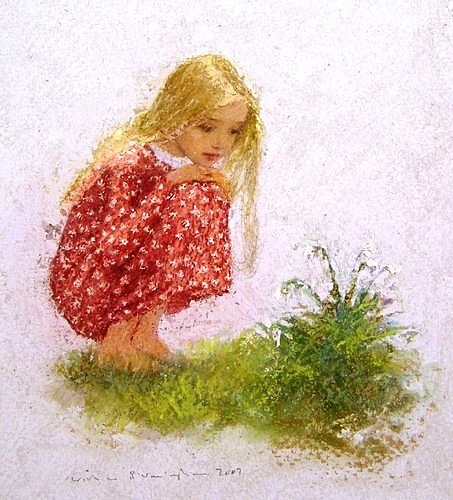
“The Snow Queen” illustrated by Christian Birmingham
Beyond the right or wrong, we meet in a field where we can embrace one another. From this singular consciousness is the portal of our heart.
There, all is created, first in oneness.
But when the portal between this oneness consciousness and the “material” world closes, then we start creating only from the mind, of duality. And then there are worries, fears, doubts, judgments, dogmas and pointing fingers. To know our truth – we must go within, through the portal of our heart, away from the matrix.
***
What I love about The Snow Queen by Hans Christian Andersen is that it is a story about the power of love and the purity of heart. Along the way, just like all of us in life, Gerda makes mistakes, she gets angry, she feels hopeless, she doubts, she takes wrong turns, she trusts the wrong people, she feels betrayed – and yet somehow she remains true to herself, with tenderness and innocence. And some people also change after they meet her, deeply touched and moved by her heart. They become kinder, more inspired, more opened and more trusting; they remember the goodness and expansion of their own hearts.
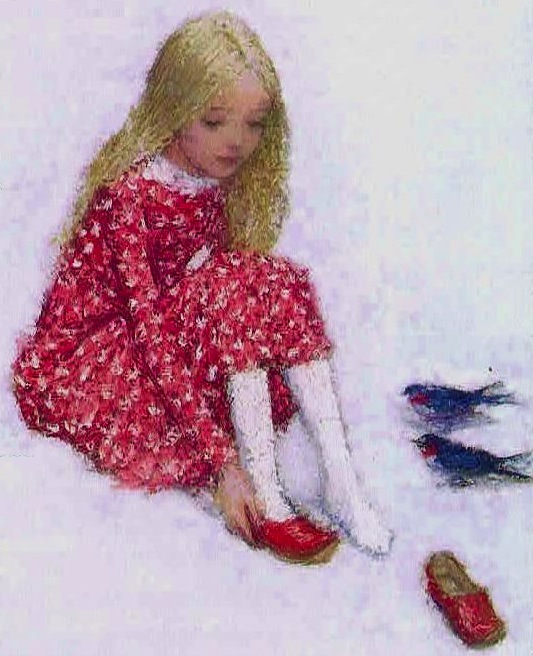
“The Snow Queen” illustrated by Christian Birmingham
The power of love is strong; it carries within it an energy that is blinding and forceful in its light. Some people will turn away from it because it just doesn’t resonate on their frequency – and that’s okay too because we are all on our own unique paths and timelines. Love purifies – and so anything preventing us from loving more will be stripped away through the light of divine love. Simultaneously, we are also shown that The Snow Queen is not a “bad” character; in her own self she is needed and purposeful as she is the one that provides the snow and ice for those who need it to survive in the winterlands.
Gerda’s consciousness is her own love which is aligned to that of the Christ – of compassion, non-judgment, patience, forgiveness, generosity, peace, faith, charity, oneness, humility, trust, joy and gratitude.
The story of Gerda shows us the cycles of the land, and of life itself through our various seasons of cold, warm, uncertainty, doubts, fears, hope, friendship and love. With her bare feet, she walks us through it all and we walk with her too.
When society exploits the Gerdas of our world – the innocent, pure and kind people – it will eventually fall apart. When the society nurtures the feelings, the emotional worlds, protects the vulnerable, and takes care of and supports one another lovingly and compassionately, it will advance. This is what brings growth to all of us, individually and collectively; when we change our internal world, the external will have no other way except to change also.
And the warmth of Gerda’s tears fell on Kay’s chest melting away the ice from his heart.
The warmth of love melts away all ice.
Love heals. Love remembers and reminds us. Love is our path, within and without.
So love consciously.
Connect to your heart because this is the portal of connection. Through our very presence in someone’s life, we make a difference. We leave little prayers along our way into the consciousness of others, because communication is energetic. Even if they seem like they haven’t resonated with it, it is still there, ingrained, and perhaps someday it will. While no one can make us see something that we don’t already have as recognized wisdom within us, we can still make a difference leaving sparkles like firefly clues along the way. When we expand our own energy through our heart, we inevitably influence that of others around us.
Love curiously. Love kindly and passionately. Love wholeheartedly. Love self. Accept yourself and allow your emotions without resisting them. Love gently until having the capacity to love with longer broader strokes. Tears and pain may fall along the way but they will transmute with more grace. Within the feelings of love, you will find yourself; you will come into your wholeness, and holiness, remembering the core of who you are and watering the dry soils of all else.
There is magic everywhere. But the only way to see it is to experience life in its deepest wisdoms – to recognize the love in its tiny, often disguised moments. Moment to moment magic will unfold.
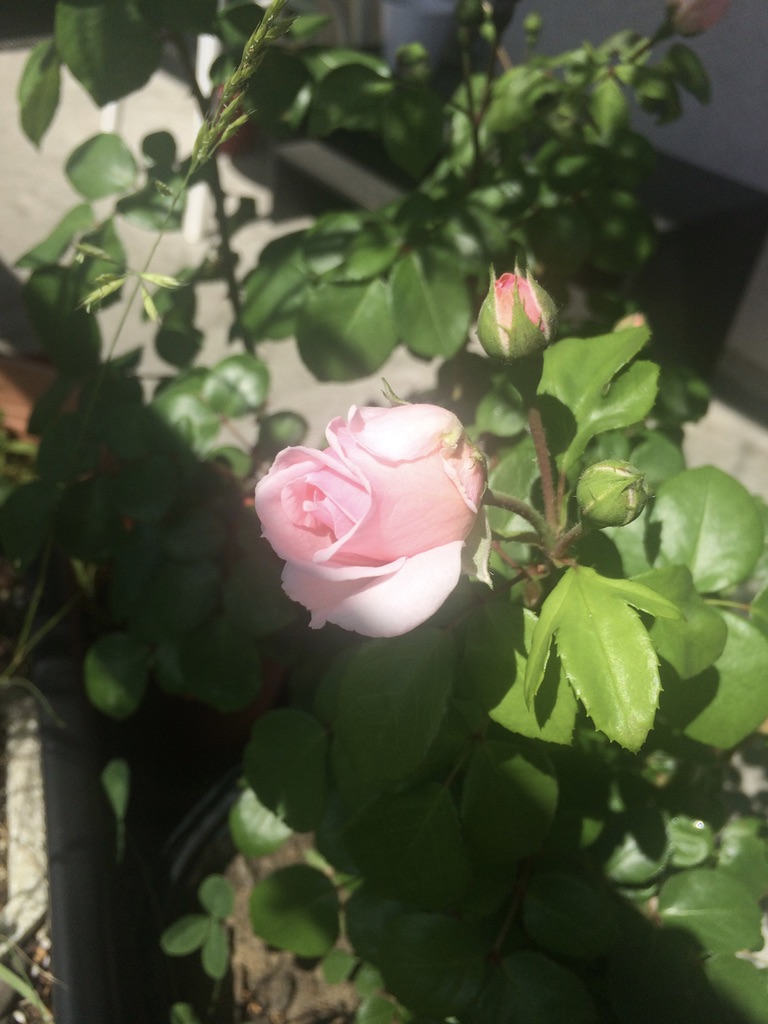
the first wild rose from my wild rose garden
To this day I have this fairytale, no longer as a vinyl record but as an old cassette tape. I still love it as much as I did. The illustrations above are from my book The Snow Queen illustrated by Christian Birmingham which sits on my shelf at this very moment as I write this. And I love roses as much as I’ve always loved them, perhaps even more.
I’ve become my own fairy – making my dreams come true such as when I published my poetry books – walking the unknown trusting, believing. Like Gerda, I follow the distant voice of something unseen yet deeply known; something deeply possessing my soul. Along the way there have been hints of it, almosts-but-not-quite. But I trust that, just like always before, one day I will find myself in the landscape, which embodies everything that I’ve been looking for perhaps my entire life. And I’ll know: here is the thing I was made for.
And here is the first wild rose that bloomed from my rose garden; a rose garden just as I had wished when I was a little girl. I remember that it bloomed exactly on my birthday a few years ago.
The scent of wild roses now reminds me of how everything unfolds in its own time, of how what’s meant for you will never pass you by because it desires you the way you desire it; and of how all we can do is just love and do our best in the meantime until it shapes before our eyes.
And each time I look at my roses, it’s as if it’s the first time, it’s as if they are magic. And so they are.

For more of my writings, browse through my Art of Love.
If you wish to support me and my work, you may do so by sharing it or donate here. For personal readings with me, you may visit my Offerings.
Your support means so much to me! Thank you wholeheartedly!
Cover Art by Maxime Simoncelli.
All rights reserved by the artists.

